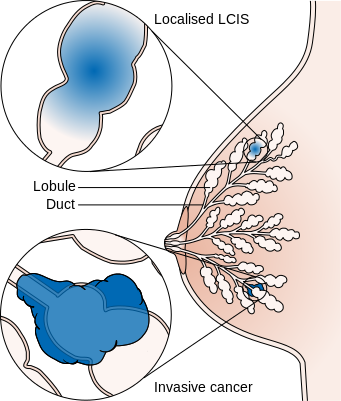 What is LCIS?
What is LCIS?
Lobular carcinoma in situ (LCIS) describes the growth of abnormal cells in the breast lobules, the milk-producing glands at the ends of the milk ducts. “In situ” means that the abnormal cells are contained in their original place and have not invaded the surrounding tissue.
Unlike ductal carcinoma in situ (DCIS), LCIS is not considered true breast cancer. Rather, it is a condition that is associated with an increased risk of developing breast cancer in the future. Because of this, some experts prefer the term “lobular neoplasia” (denoting the development of abnormal lobular cells) rather than referring to this condition as “carcinoma.”[1] Women with LCIS have 8-10 times the average risk of developing invasive breast cancer in either the lobules or the milk ducts.[2]
What are the symptoms of LCIS?
Unlike many forms of breast cancer, LCIS typically causes no symptoms, and it often does not appear on screening mammograms. One reason for this is that microcalcifications, which form in other types of breast cancer cells and appear as white specks on a mammogram, may not be present with LCIS.[3] As a result, many cases go undiagnosed, and often, this causes no harm.
How is LCIS diagnosed?
When LCIS is diagnosed, it’s usually a result of a biopsy investigating another breast condition in the vicinity of the abnormal cells.[4] Under a microscope, LCIS can look much like DCIS. Both are described as “stage 0,” meaning that the abnormality has not spread beyond the original site.[5]
LCIS is most often diagnosed before menopause, between the ages of 40 and 50.[6] More than half of patients are found to have abnormal cells in more than one lobule (called “multifocal” LCIS), and in about one third of LCIS patients, both breasts are affected.[7]
How is LCIS treated?
Enhanced Screening
Because the presence of LCIS indicates an elevated breast cancer risk, it is especially important that patients with the condition continue to get regular screening mammograms. The American Cancer Society and the National Comprehensive Cancer Network offer these guidelines for LCIS patients to ensure that any breast cancer that may develop is caught as early as possible:
-
 Get clinical breast exams every 6-12 months.
Get clinical breast exams every 6-12 months. - Get annual screening mammograms.
- Talk to your doctor about regular screening using breast MRI.[8]
Medications
Some patients with LCIS choose to take medications to lower their risk of developing breast cancer (called “chemoprevention”). A recent study found that women with LCIS have a 2% annual risk of developing breast cancer, and those who choose chemoprevention lower that annual risk to below 1%.[9] The two drugs approved by the FDA for this purpose are tamoxifen and raloxifene. Tamoxifen is slightly more effective at reducing breast cancer risk, but it is also associated with more harmful side effects than raloxifene. While women of any age can take tamoxifen, raloxifene is prescribed only to postmenopausal women.[10] Talk to your doctor about the risks and benefits of chemoprevention if you have been diagnosed with LCIS.
Surgery
LCIS patients at higher risk, such as those with a family history of breast cancer or BRCA gene mutation, may choose surgery to control their risk. Sometimes only the affected tissue is surgically removed; in that case, follow-up examinations are important because the patient will still be at higher than average risk of breast cancer. Some women with high breast cancer risk choose to undergo prophylactic mastectomy, in which both breasts are removed as a preventive measure.[11] It’s important to discuss all of your risk factors and treatment options with your doctor.
Iowa Radiology provides breast imaging at our clinics in Clive, Ankeny, and Downtown Des Moines. We use a variety of imaging techniques, including breast MRI and low-dose 3-D mammography. We believe in providing our patients with the information they need to make informed health care choices. Download our ebook to learn more about what to expect during your MRI.
The information contained in the Iowa Radiology website is presented as public service information only. It is not intended to be nor is it a substitute for professional medical advice. You should always seek the advice of your physician or other qualified healthcare provider if you think you may have a medical problem before starting any new treatment, or if you have any questions regarding your medical condition. Iowa Radiology occasionally supplies links to other web sites as a service to its readers and is not in any way responsible for information provided by other organizations.
Sources
[1] "Lobular carcinoma in situ (LCIS)." Cancer.org. American Cancer Society, n.d. Web. 1 Dec 2015.
[2] "Lobular carcinoma in situ (LCIS)." BreastCancer.org. n.p., n.d. Web 1 Dec 2015.
[3] "Symptoms and Diagnosis of LCIS." BreastCancer.org. n.p., n.d. Web. 1 Dec 2015.
[4] "Lobular carcinoma in situ (LCIS)." BreastCancer.org. n.p., n.d. Web 1 Dec 2015.
[5] "Symptoms and Diagnosis of LCIS." BreastCancer.org. n.p., n.d. Web. 1 Dec 2015.
[6] "Lobular carcinoma in situ (LCIS)." Cancer.org. American Cancer Society, n.d. Web. 1 Dec 2015.
[7] "Symptoms and Diagnosis of LCIS." BreastCancer.org. n.p., n.d. Web. 1 Dec 2015.
[8] "Lobular Carcinoma in Situ (LCIS)." Komen.org. Susan G. Komen, n.d. Web. 1 Dec 2015.
[9] King, et al. "Lobular Carcinoma in Situ: A 29-Year Longitudinal Experience Evaluating Clinicopathologic Features and Breast Cancer Risk." Journal of Clinical Oncology. American Society of Clinical Oncology, 14 Sept 2015. Web. 1 Dec 2015.
[10] "Lobular Carcinoma in Situ (LCIS)." Komen.org. Susan G. Komen, n.d. Web. 1 Dec 2015.
[11] "Lobular carcinoma in situ (LCIS) — Treatment and Drugs." Mayo Clinic. Mayo Foundation for Medical Education and Research, n.d. Web. 1 Dec 2015.
Image Source: "Diagram showing lobular carcinoma in situ (LCIS) CRUK 166" by Cancer Research UK - Original email from CRUK. Licensed under CC BY-SA 4.0 via Commons - https://commons.wikimedia.org/wiki/File:Diagram_showing_lobular_carcinoma_in_situ_(LCIS)_CRUK_166.svg#/media/File:Diagram_showing_lobular_carcinoma_in_situ_(LCIS)_CRUK_166.svg


